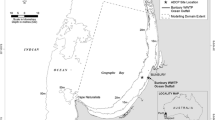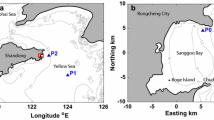Abstract
Net-pen aquaculture results in the introduction of excess fish food and fecal matter in coastal waters. These wastes may modify the benthic environment. Mathematical models are developed in this study to simulate tidal and wind-driven currents, waves, and the resulting dispersion of fish food and fecal matter in coastal Maine, a region where limited modelling studies have been performed. Cobscook Bay and Toothacher Bay in Maine are studied in detail through the use of mathematical models and field data. We find that a systematic, site-specific, step-by-step modeling strategy involving the use of numerical models to simulate the overall hydrodynamic environment in combination with a waste-particle transport model can be an extremely powerful method of determining a priori whether aquaculture operations will cause high rates of net-pen waste accumulation at a particular site.
Similar content being viewed by others
Literature cited
Ackerfors, H. andM. Ennel. 1990. Discharge of nutrients from Swedish fish farming to adjacent sea areas.Ambio 19:28–35.
Amos, C. L., J. Grant, G. R. Daborn, andK. Black. 1992. Sea Carousel—A benthic, annular flume.Estuarine, Coastal and Shelf Science 34:557–577.
Aure, J. andA. Stigebrandt. 1990. Quantitative estimates of the eutrophication effects of fish farming on fjords.Aquaculture 90:135–156.
Bettencourt, S. U. andJ. L. Anderson. 1990. Pen-reared salmonid industry in the Northeastern United States. Northeast Regional Aquaculture Center Publication No. 100. College of Resource Development, University of Rhode Island. Lippitt Hall, Kingston, Rhode Island 02881.
Booij, N. 1989. User Manual for the program DUCHESS, Delft University computer program for 2D horizontal estuary and sea surges. Department of Civil Engineering, Delft University of Technology, Delft, The Netherlands.
Brooks, D. andL. Churchill. 1992. Experiments with a terrain-following hydrodynamic model for Cobscook Bay in the Gulf of Maine, p. 215–225.In M. Spaulding (ed.), Proceedings, Second International Conference in Estuarine and Coastal Modeling. American Society of Civil Engineers, New York.
Ferland, J. G., C. R. Newell, andJ. A. Wilson. 1990. An Aquaculture Development Strategy for the State of Maine. Maine State Planning Office, Augusta, Maine.
Findlay, R. H. and L. Watling. 1994. Toward a process level model to predict the effects of salmon net-pen aquaculture on the benthos, p. 47–77.In B. T. Hargrave (ed.), Modeling Benthic Impacts of Organic Enrichment from Marine Aquaculture.Canadian Technical Report of Fisheries and Aquatic Sciences 1949.
Findlay, R. H., L. Watling, andL. M. Mayer. 1995. Environmental impact of salmon net-pen culture on Maine marine benthic communities: A case study.Estuaries 18:145–179.
Fox, W. P. 1988. Modeling of particulate deposition under salmon net-pens. Report to Washington Department of Fisheries. Parametrix, Inc., Washington.
Gowen, R. J. andN. B. Bradbury. 1987. The ecological impacts of salmonid farming in coastal waters: A review.Oceanography and Marine Biology an Annual Review 25:563–575.
Gowen, R. J., N. B. Bradbury, andJ. R. Brown. 1989a. The use of simple models in assessing two of the interactions between fish-farming and the marine environment. p. 1071–1080.In N. DePauw, E. Jaspers, H. Ackerfors, and N. Wilkins (eds.), Aquaculture—A Biotechnology in Progress. European Aquaculture Society, Belgium.
Gowen, R. J., H. Rosenthal, T. Makinen, andI. Ezzi. 1989b. Environmental impact of aquaculture activities, p. 257–283.In N. DePauw, and R. Billard (eds.), Aquaculture Europe '89—Business Joins Science. European Aquaculture Society, Belgium. Spcl. Publ. No. 12.
Gowen, R. J. andA. Edwards. 1990. The interaction between physical and biological processes in coastal and offshore fish-farming: An overview, p. 39–47.In Engineering for Offshore Fish Farming, Thomas Telford, London.
Gowen, R. J., D. Smyth, and W. Silvert. 1994. Modelling the spatial distribution of loading of organic fish farm waste to the seabed, p. 19–30.In B. T. Hargrave (ed.), Modeling Benthic Impacts of Organic Enrichment from Marine Aquaculture.Canadian Technical Report of Fisheries and Aquatic Sciences 1949.
Greenberg, D. A. 1983. Modelling the mean barotropic circulation in the Bay of Fundy and Gulf of Maine.Journal of Physical Oceanography 13:886–904.
Hall, P. O. J., L. G. Anderson, O. Holby, S. Kollberg, andM. Samuelsson. 1990. Chemical fluxes and mass balances in a marine fish cage farm. I. Carbon.Marine Ecology Progress Series 61:61–73.
Hansen, P. K., K. Pittman, andA. Ervik. 1991. Organic waste from marine fish farms-effects on the seabed, p. 105–119.In T. Makinen (ed.), Marine Aquaculture and Environment. Nord 1992: 22. Nordic Council of Ministers, Copenhagen, Denmark.
Hess, K. W. 1989. MECCA program document. National Oceanic and Atmospheric Administration Technical Report NESDIS 46, Washington, D.C.
Jin, X. andC. Kranenburg. 1993. Quasi-3d numerical modeling of shallow-water circulation.Journal of Hydraulic Engineering 119:458–472.
Koutitas, C. G. 1988. Mathematical Models in Coastal Engineering. Pentech Press, London.
Langendoen, E. J. andC. Kranenburg. 1993. Simulation of unsteady flow in harbors, p. 1612–1617.In S. Wang (ed.), Advances in Hydro-Science and Engineering, vol. 1, Center for Computational Hydroscience and Engineering, School of Engineering, University of Mississippi, University, Mississippi.
Lardner, R. W. andH. M. Cekirge. 1988. A new algorithm for three-dimensional tidal and storm surge computations.Applied Mathematical Modeling 12:471–480.
Luettich, R. A. andD. F. Harlemann. 1990. A comparison between measured wave properties and simple wave hind-casting models in shallow water.Journal of Hydraulic Research 28:299–308.
Mehta, A. 1993. Nearshore and Estuarine Cohesive Sediment Transport. Coastal and Estuarine Studies, v. 42, American Geophysical Union, Washington, DC.
Newell, C. R. 1991. Development of a model to seed mussel bottom leases to their carrying capacity, Phase 2 report, NSF SBIR, ISI8809760.
Newell, C. R. andS. E. Shumway. 1993. Grazing of natural particulates by bivalve molluscs: A spatial & temporal perspective, p. 85–148.In R. F. Dame (ed.), NATO ASI Series, vol G33, Bivalve Filter Feeders, in Estuarine & Coastal Ecosystems Processes. Springer Verlag, Berlin.
Panchang, V. G., G. Cheng, and C. Newell. 1993. Application of Mathematical Models in the Environmental Regulation of Net-pen Aquaculture. Maine-NH Sea Grant Program, MSG-TR-93-1.
Panchang, V. G., B. Xu, and Z. Demirbilek. In press. Wave models for coastal applications.In J. Herbich (ed.), Handbook of Coastal Engineering. Gulf Publishing Company, Houston, Texas.
Parametrix Inc. 1990. State of Maine Aquaculture Monitoring Program. Report prepared for Maine Department of Marine Resources. Bellevue, Washington.
Pillay, T. V. R. 1992. Aquaculture and the Environment. Halsted Press, New York.
Sanford, L. P. 1994. Wave-forced resuspension of upper Chesapeake Bay muds.Estuaries 17(1B):148–165.
Silvert, W. 1992. Assessing environmental impacts of finfish aquaculture in marine waters.Aquaculture 107:67–69.
Sucsy, P. V., B. Pearce, andV. G. Panchang. 1993. Comparison of two- and three-dimensional model simulation of the effect of a tidal barrier on the Gulf of Maine tides.Journal of Physical Oceanography 23(6):1231–1248.
Thorpe, J. E., C. Talbot, M. S. Miles, C. Rawlings, andD. S. Keay. 1990. Food consumption in twenty four hours by Atlantic salmon (Salmon salar L.) in a sea cage.Aquaculture 90:41–47.
United States Army Corps of Engineers. 1984. Shore Protection Manual. Coastal Engineering Research Center, Waterways Experiment Station, United States Army Corps of Engineers, Vicksburg, Mississippi.
United States Army Corps of Engineers. 1992. Automated Coastal Engineering System. Coastal Engineering Research Center, Waterways Experiment Station, United States Army Corps of Engineers, Vicksburg, Mississippi.
United States Environmental Protection Agency. 1982. Revised Section 301 (h) Technical Support Document, by Tetra Tech. Inc., EPA Pub. 430/9-82-011.
Warren-Hansen, I. 1982. Report on EIFAC Workshop on fishfarm effluents, p. 57–63.In J. S. Alabaster (ed.), Evaluation of Matter Discharged from Trout Farming in Denmark. Food and Agricultural Organization of the United Nations, Rome.
Wei, G., V. G. Panchang, andB. R. Pearce. 1990. Some numerical models for predicting wave conditions around aquaculture sites, p. 119–136.In Engineering for Offshore Fish-Farming, Thomas Telford, London.
Weston, D. P. and R. J. Gowen. 1988. Assessment and Prediction of the Effects of Salmon Net-pen Culture on the Benthic Environment. Prepared for Washington Department of Fisheries, Washington.
Author information
Authors and Affiliations
Rights and permissions
About this article
Cite this article
Panchang, V., Cheng, G. & Newell, C. Modeling hydrodynamics and aquaculture waste transport in coastal maine. Estuaries 20, 14–41 (1997). https://doi.org/10.2307/1352717
Received:
Accepted:
Issue Date:
DOI: https://doi.org/10.2307/1352717




